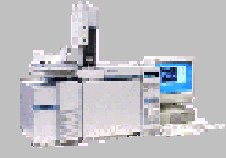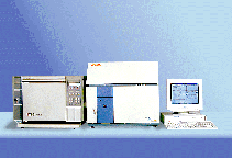

© 1997, Dissolved In Water Incorporated. CEO's: Mike
Lewis, Emma Teuten, and Paul Benny. All rights reserved.
|
WAGING WAR ON DRUGS WITH GAS CHROMATOGRAPHY-MASS SPECTROMETRY |
 |
|
 |
 |
 |
 |
| Mike Lewis | Emma Teuten | Paul Benny |
Group Meetings
Introduction
The war on drugs requires quick and efficient analysis of
contrabands. Unfortunately, rapid analysis becomes tougher each
year because of the increasing number of drug related crimes. The
resultant quandary for local district attorneys (DA's) stems from
the firm stance on due process taken by the justice system. New
York city is one place where this judicial problem is paramount.
This is illustrated by the DA's court imposed deadline of three
weeks for all drug analyses. Thus, Dissolved In Water Incorporated
(DIW Inc.) has recently been hired by the New York City Police
Department to aid them in their investigations of drug related
crimes. Our task is to analyze materials that are seized from
suspected drug distributors. The main emphasis of our work will be
qualitatively determining whether the samples do indeed contain
illegal drugs. We will be required to identify a vast number of
compounds that vary greatly in their functionalization and
molecular weight. Two such examples that describe this range are
amphetamine with MW=135 and heroin with MW=323.
Discussion
The information age has broadened the scope of research.
The World Wide Web allowed us quick and easy access to the
companies who produce pre-assembled GC-MS's. We were then able to
contact companies via electronic-mail, facsimile, and telephone.
We narrowed the long list of companies who sell analytical devices
by searching the internet and concentrated on distributors who sold
bench-top GC-MS's. Consequently, our attention focused on the
following five companies (click on their logos to visit their home page).
For this project DIW Inc. will be state-funded. While this
means that money is not a major concern, we intend to respect the
tax payer and purchase the equipment that is the best possible
value. It is our intention to procure a bench-top GC-MS. This
offers two advantages. First, this will allow us to hire a chemist
with only a BS background, who could be easily trained on a generic
GC-MS and would require less pay than a more educated chemist.
Second, a bench-top GC-MS has the advantage of being pre-assembled.
Hence, if technical problems arise a quick solution could be
obtained from the distributor. A self-assembled GC-MS would
require a highly educated mass spectroscopist for operation and
maintenance. Therefore we are interested in a bench-top GC-MS
which is both easy to use and to maintain. This automatically
eliminated the high-end machines which all tend to be
self-assembled, thus creating the above described dilemmas. Also,
our primary concern is quick and basic qualitative analysis. Thus,
an expensive GC-MS that performs a much wider range of tasks is not
necessary nor cost efficient. The two companies that we decided to
obtain quotes from were Hewlett Packard and JEOL. These two
companies both offer bench-top devices with electron ionization
(EI), positive chemical
ionization (PCI)
and negative chemical
ionization (NCI).
This would impart us the with the capability to
perform analyses with multiple ionization sources. Such multiple
analyses allow us to cross reference any questionable results and
unambiguously report the presence of any contrabands.
The instruments that we obtained quotes for were the HP
5973 MSD/HP 6890 GC from Hewlett Packard, and the JMS-GCmate from
JEOL. The main difference between the two was the price. The
Hewlett Packard GC-MS has a price tag of approximately $80,000.00,
while the cost of the JEOL instrument was almost $160,000.00.
Thus, our immediate goal was to discern whether the JEOL machine
was worth twice as much. Both products offer EI, NCI and PCI
capability. As we alluded to earlier, this is important because it
lends confirmation to the analyses. If all three ionization
techniques point to the presence of a certain drug, one can be
certain the characterization is accurate. Another useful
application offered by both instruments is the ability to monitor
selected ions. This would allow the fragmentation pattern analysis
of a specific analyte, while ignoring any other ions present in the
sample. Considering that we will be dealing with illicit drugs,
this feature is important as many of the samples may be impure.
The JEOL system does offer some features that the Hewlett Packard
instrument does not. For instance, the JEOL device has the
capability of background subtraction and elemental analysis.
However, both of these features are amenities that are not
imperative to our work so long as we are able to monitor for
selected ions. Despite being considerably cheaper, the Hewlett
Packard machine offers features not present on the JEOL system.
For example, the Hewlett Packard GC-MS is equipped with software
that allows for complete automation from injection through data
analysis. This will enable us to run the samples 24 hours day unmanned.
Moreover, the Hewlett Packard device contains further software that
allows for remote access of the GC-MS. This remote access will let
us control the machine from any location, along with giving Hewlett
Packard technicians the ability to immediately help with any
mechanical problems. This will assure that the system experiences
limited down time. The final point to make with regards to the two
systems is that the GC component of the JEOL system is the HP 6890
GC. Thus, JEOL utilizes the Hewlett Packard GC in its GC-MS
device. As a result, it is more expensive to purchase the HP 6890
GC through JEOL than it is through Hewlett Packard. Also, we are
lead to the assumption that maintenance of the HP 6890 GC will be
more expensive through JEOL than through Hewlett Packard.
As we already pointed out, the JEOL JMS-GCmate system is
substantially more expensive than the Hewlett Packard HP 5973
MSD/HP 6890 GC device. The following is a tabulated comparison of
the components for each system (click on the instrument to visit its
homepage).
The MS component for the JEOL JMS-GCmate instrument
includes a double-focusing ion optics bench, a multiple
quadrupole-based focusing lens, and has EI, NCI and PCI
capabilities. It has a mass range of 1000 au, and is coupled with
an HP6890 gas chromatograph. The JMS-GCmate also comes equipped
with a Pentium PC, an HP LaserJet, and the NIST MS Spectral
Library. The MS component for the HP 5973 MSD/HP 6890 GC contains
a single gold quadrupole mass filter, and has a mass range of 800
au. Similar to the JMS-GCmate system, the HP 5973 MSD/HP 6890 GC
instrument also has EI, PCI and NCI capabilities. The cost
discrepancy between the two quotes is that Hewlett Packard's price
does not include tax, however it does include a ten percent
discount. Conversely, JEOL's price does not have a discount, but
it does include tax. Thus, an accurate comparison between the two
quotes should include tax on the Hewlett Packard system, which
would increase the its price by approximately $10,000.00.
Conclusion
Group Dynamics
Mike Lewis
Emma Teuten
Paul Benny






